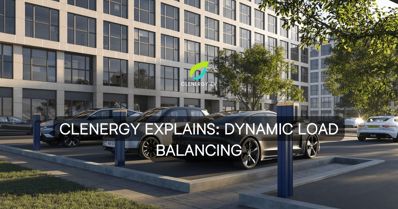Let’s start by stating the obvious; electric vehicle (EV) adoption across the UK is starting to accelerate.
According to the LGA, the number of EVs expected to be on UK roads by 2030 will be between 8-11 million, representing a potential 1300% increase on current figures. As organisations adjust to the new rollback of the new ICE sale ban to 2035, much of this figure will be formed from companies and local authorities intent on meeting their original emission targets, and looking to reap the benefits of energy efficiency and the cost savings of their fleet sooner rather than later. And to facilitate this change, our focus will have to remain on improving our charging infrastructure, which has often been cited as a cause for concern among drivers and industry experts.
Having hit a milestone number of 50,000 chargepoints this year, we’ve so far gone some way to showing our intent to keep pace with adoption as we aim to double that figure by 2024 alone. And these chargepoints installation numbers are backed not only by the 2035 new ICE sale ban that will see 80% of sales by ZEVs by 2030, but also by major government funding for the development of charging infrastructure, as this 1300% growth forecast by 2030 is currently facilitated by schemes like the generous OZEV EV infrastructure Grant, covers up to 75% of the cost of installing the necessary infrastructure for chargepoints.
Add to this Labour plans to overturn the government’s latest pushback of the 2030 ICE ban date, as well as promises to release existing infrastructure funding such as the £950 million attributed to the Rapid Charging Fund (announced March 2020), and a picture starts to form of a country rising to the challenge of EV adoption - and fast.
The challenge for our infrastructure, as proven by the areas of investment provided, will be in scaling up efficiently, and continuing to deliver EV charging* in a way that keeps drivers overwhelmingly happy with the EV experience. Whilst the Government has set a target of delivering 300,000 chargers by 2030, according to The Society of Motor Manufacturers and Traders (SMMT), the UK could require about 2.3 million. With 50,000 chargers currently installed across the UK network and a minimum of 250,000 (42,000 each year) required, it’s obvious that there’s a huge opportunity for those looking to get in on the groundfloor in building our EV infrastructure. But alongside increasing our raw numbers, it’s just as essential that those running our charging networks proactively look to establish a strategy for operational success.
We know that Chargepoint Operators (CPOs) involved building, installing and maintaining EV charging stations will be key to delivering a charging infrastructure that rises to the challenge of mass adoption to become fair, easy to use, and accessible for all. So because of this, it’s important that those in the industry understand the following to enable the uninhibited growth of our CPO network:
- Key considerations for CPOs - what challenges do they face, and what do their strategies need to address?
- How CPOs can best optimise their businesses.
- How our existing installed network, and EV charging software in particular, can help.
Top Priorities for Chargepoint Operators
Reliability
When it comes to operating a charging network, the first thing CPOs are thinking about is reliability. With new Government regulations for rapid chargepoints mandating for a 99% reliability rate as of 2024 (that is, that chargepoints be operational for 99% of the time), chargepoint reliability has been rightly identified as a cornerstone of instilling consumer confidence in our infrastructure and the EV market in general. What operators - especially those in the EV market - don’t often realise, is how easy EV charging software makes it.
EV charging software is your first line of defence for a downed charger. Not only does it give you full visibility of your network, but it also puts the power in your hands to get a fix as soon as possible. At Clenergy EV, our smart software operates with remote maintenance capabilities, allowing for a reset of your systems in the event of malfunction. And beyond that, we’ll save time and money on your maintenance by sending you the precise error code for your downed charger, allowing maintenance teams to visit the site with the correct tools and know-how to fix quickly and efficiently.
Scalability
Right now, EV as an industry is hinged upon the promise of market growth. For CPOs, their model will be no different. When they install chargepoints, it’s essential to them that both the physical hardware they’re installing (including the installation model) and the software/management system backing it are scalable for rapid growth.
In transitioning to EVs, it’s largely recognised that the first step into the market is the hardest. And it’s important for CPOs not to repeat this step each time they look to expand their network; so scalability can be a key selling point when evaluating EV technology.
Aside from the commercial aspect of this, a relatively nascent industry needs to be building its infrastructure to accommodate the inevitable technological advancements - without having to start again by ripping out existing chargepoints, which could be the case if you unwittingly buy into hardware and software bundles that lock you into long term contracts. It’s why, there is more talk around OCPP (Open Chargepoint Protocol) compliant hardware, which allows you to add different chargers to an evolving network based on need.
We could talk about this all day, but essentially, a software-first approach to EV procurement means that CPOs can ensure they’re free to install any compliant hardware (as the market develops) without having to rip out older chargers and effectively rebuild from scratch.
Managing Different Vehicle Needs
For those managing internal fleets, it’s essential that whatever hardware and software they’re investing in is compatible with different vehicles. Across an organisation, you may have vehicles ranging from normal staff cars essential in travelling across site, to large freighter lorries transporting goods and supplies up and down the country. Having the ability to manage these both from a single point is essential to those inside these organisations in making sure that their workload isn’t doubled.
With back office software, these different groups can be subdivided to gain specific insights for smarter decision making, whilst feeding in to one overarching support and management system. Without it, CPOs will be left juggling multiple different systems with different functionality, making it even harder to ensure things like reliability and guideline adherence across a network.
Adherence to Ever-Changing Guidelines
We’ve already mentioned in this article the need to adhere to updated government guidelines, but their importance to CPOs is huge. As discussed in the case of meeting the 99% reliability requirement, back-office software can be an unexpected ally in making sure the chargepoints in your network come built with guideline compliance in mind.
CPOs need to consider:
|
Requirement |
Provided by Clenergy EV software |
|
Reliability - Live reporting and diagnostics on charger health. |
✅ |
|
24/7 Customer service - Our helpdesk is available 24/7 for both drivers and operators. |
✅ |
|
Open Data - Access charging data as a guest through our app. |
✅ |
|
Varied payment options - Multiple options processed by Stripe. |
✅ |
Reducing Operational Costs, and Making EV Charging Easy
Chargepoint Management and Decision-making
After putting chargers in the ground, the next step for CPOs is data. CPOs need to receive data in real time, so they can make informed decisions to drive through their charging strategies. As a pioneer in EV transitioning, Nottingham City Council used our back-office software to manage their large internal fleet network of 250 vehicles at the time of writing.
Nottingham City Council used our chargepoint management system (CPMS) to interrogate their data and were able to identify a pattern where employees were charging at the end of shifts or during the day. They were then able to direct them to charge overnight, making use of cheaper off peak electricity tariffs. This move alone can go a long way to reducing operational costs, and ensuring the success of an EV transition; Nottingham City Council have saved over £1million in running costs and 1162 tonnes of CO2 emissions every year since their EV transition.
Energy Management
Another factor chargepoint operators must consider is the management of energy expenditure on their sites. Without the use of smart software technology, CPOs run the risk of shorting the grid by plugging in too many vehicles at once and exceeding grid limits. Instead, features such as load balancing allow for the even distribution of available grid power across units, meaning you won’t cause an outage no matter the number of vehicles plugged in at once.
This is a valuable asset to CPOs, who would otherwise be left with a greater operational challenge and a risk that many new to the industry may not consider until later in their journey. With software, these features are in-built, and don’t necessarily require any input from CPOs - acting as just another instance of back office platforms tackling issues in the background.
It’s also important for CPOs to remember that due to grid limitations, charge times may not always be as quick as expected. You can find a quick explainer on this here, under the sub-head ‘why is my charge taking so long’.
How CPOs Can Maximise ROI and Increase User Benefits
There are usually two main types of business models applied by chargepoint operators: profit-making, and cost recovering. These will vary in deployment depending on the sector of the CPO, with public sector operators tending to look more at the asset recovery side than necessarily making a profit on their chargepoints. For them, the objective is to build the infrastructure to cope with not only the demand brought by their own internal fleet transition to EVs heralded by government policy, but also the demand expected across their jurisdiction through mass general adoption.
Similarly, profit-making models are often the result of an initial internal need to build chargepoints to facilitate new EVs for a business. As they look to meet sustainability goals through their EV transition, smart decision making enabled by back-office software allows for the potential to open up their chargepoint to the public, giving a chance, as with local authorities, to widen the charging network while in this case able to make a ROI on chargers when they’re not being used for their fleet (typically out of hours).
In both cases, when looking at opening their networks to public charging there are a variety of key decisions that CPOs will have to think about. These include:
- Location: Government reports carried out by the Geospatial Commision have recently stressed the importance of location of sites for CPOs. They need to select areas of high traffic, backed by data to ensure demand. Without software, CPOs simply wouldn’t have access to this kind of data.
- User Experience: Anyone getting involved in the EV market will understand the critical stage we’re at. With press coverage on negative EV experiences frequent, it’s essential to CPOs that users experience a counter narrative at chargers on their network. Partnering with trusted back-office software providers, who provide 24/7 customer service can go some way to alleviating that pressure.
- Charging speed: According to Welsh government targets, an increase in publicly-available rapid chargers by 4,000 units will be needed by 2030. Apply this UK wide, and we see a massive need for these faster charging speeds, which indicates CPOs should look to future proof their network with rapid charging installations. A good software provider will work with any OCPP compliant hardware, giving another reason to shop software first in case you find the need to upgrade existing chargers in your network.
Setting Up The Future
Overall, the opportunities for CPOs are undeniably huge. Getting in on a market growing exponentially with no signs of slowing represents great potential, and gives a massive incentive to navigate some of the potential pitfalls expected. Especially as software can resolve many of them.
As software providers our mission is to facilitate an EV infrastructure that is fair and easy for all. It’s from this brief that all our product features are developed, and it’s how we’re able to build in ways that ensure you are able to deliver a positive customer experience across your network, backed by reliability and ease of use.
We’re calling on the industry as a whole to adopt socially responsible business practice that addresses better energy management, EV billing and payment, asset management and business operations through future-proofed product development.
To understand how leaders in this space have used Clenergy EV charging software to drive change and mitigate pitfalls when doing so visit our case study for real life examples, or contact us via the details below.



